Information about the Australian National Flag is also available on this website.
Australian Aboriginal Flag
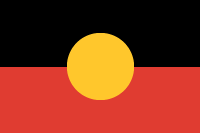
The Australian Aboriginal Flag was first raised on 9 July 1971 at Victoria Square in Adelaide. It was also used at the Aboriginal Tent Embassy in Canberra in 1972. Mr Harold Thomas from Northern Australia designed the flag.
The top half of the flag is black to symbolise Indigenous people. The red in the lower half stands for the earth and the colour of ochre, which has ceremonial significance. The circle of yellow in the centre of the flag represents the sun.
The Australian Aboriginal Flag is displayed at Aboriginal centres and is well recognised as the flag of Aboriginal peoples of Australia. It is flown during NAIDOC Week to celebrate and promote greater understanding of Indigenous peoples and culture and during National Reconciliation Week in recognition of 27 May as the anniversary of the 1967 Referendum which removed from the Constitution clauses that discriminated against Indigenous Australians and 3 June as the anniversary of the High Court decision in the Eddie Mabo land rights case of 1992.
Colour references for the Australian Aboriginal Flag are:
- Red PANTONE® 179
- Yellow PANTONE® 123
The Australian Aboriginal Flag was proclaimed on 14 July 1995.
The Commonwealth owns the copyright of the Australian Aboriginal Flag. Carroll & Richardson-Flagworld Pty Ltd is the exclusive licensed manufacturer and provider of the Australian Aboriginal Flag on flags and pennants, banners and buntings. Requests for permission to reproduce the Australian Aboriginal Flag on those mediums should be addressed to Carroll & Richardson-Flagworld Pty Ltd:
Flagworld Pty Ltd
22-24 Miles Street
Mulgrave VIC 3170
Phone: 1800 135 247
International: +61 3 9566 4500
The Commonwealth allows the design of the Australian Aboriginal Flag to be freely reproduced by the public on all other mediums.
The Australian National Flag takes precedence in Australia over all other flags when it is flown in company with other flags. Accordingly, when the Australian Aboriginal Flag is to be flown along with the Australian National Flag, the Australian National Flag should be flown in the position of honour. More on flag protocols can be found in the Australian Flags Booklet.
Torres Strait Islander Flag
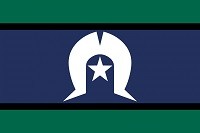
The Torres Strait Islander Flag was adopted in May 1992 during the Torres Strait Islands Cultural Festival.
The green panels at the top and bottom of the flag represent the land and the central blue panel represents the sea. The black lines dividing the panels represent the Torres Strait Islander people.
The centre of the flag shows a white Dhari (traditional headdress) and is a symbol for all Torres Strait Islanders.
Underneath the Dhari is a white five-pointed star. The star is an important symbol for navigating the sea. The points of the star represent the island groups in the Torres Strait and white symbolises peace.
Colour references for the Torres Strait Islander Flag are:
- Blue PANTONE® 280
- Green PANTONE® 342.
The Torres Strait Islander Flag is flown during NAIDOC Week and Reconciliation Week.
The design of the Torres Strait Islander Flag was the winning entry in a competition organised by the Island Coordinating Council.
The Torres Strait Islander Flag was proclaimed on 14 July 1995.
Permission is not required to fly the Torres Strait Islander Flag. The Australian National Flag takes precedence in Australia over all other flags when it is flown in company with other flags. Accordingly, when the Torres Strait Islander Flag is to be flown along with the Australian National Flag, the Australian National Flag should be flown in the position of honour. More on flag protocols can be found in the Australian Flags Booklet.
The Torres Strait Island Regional Council holds copyright in the Torres Strait Islander Flag. Requests for permission to reproduce the Torres Strait Islander Flag should be addressed to the Records Officer of the Island Regional Council. Contact details are:
Torres Strait Island Regional Council
PO Box 7336
Cairns QLD 4870
Phone: 07 4034 5700
Fax: 07 4034 5750
Further information on reproduction requirements is available on the Torres Strait Island Regional Council website.
Defence Ensigns
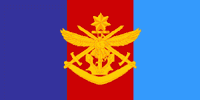
The flags of the Australian Defence Force and government services have also become known as ensigns.
The Australian Army has no separate ensign but has the ceremonial role of protector of the Australian National Flag.
The Australian Defence Force ensign represents the three services of the Australian Defence Force. The defence force emblem in the centre of the flag is a symbol of the three services. The crossed swords represent the Australian Army, the anchor represents the Royal Australian Navy and the eagle represents the Royal Australian Air Force.
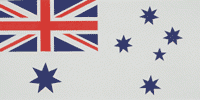
The red stripe on the flag represents the Australian Army, the dark blue stripe represents the Royal Australian Navy and the light blue stripe represents the Royal Australian Air Force.
The Commonwealth Star and the boomerang on the Australian Defence Force ensign represent Australia.
The Australian Defence Force ensign was proclaimed on 12 April 2000.
The Royal Australian Navy adopted the Australian white ensign in 1967. The Australian white ensign is an Australian National Flag with a white background. It is flown from the stern of naval vessels. The Australian National Flag is flown from the bow.
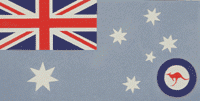
The Royal Australian Air Force ensign was adopted in 1948. It is an Australian National Flag with a light blue background. A leaping red kangaroo was added in 1982. Permission is required to fly or use a Defence ensign. You should contact the relevant service brand manager to seek permission.
Order of Precedence for Defence Ensigns
The order of precedence for Defence ensigns is:
- Australian National Flag
- Australian Defence Force ensign
- Australian white ensign
- Royal Australian Air Force ensign
Australian Red Ensign
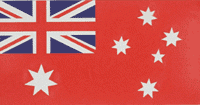
When the Commonwealth Government announced a competition to design a flag for Australia in 1901, entrants were asked to send a design for two flags – one for official and naval purposes and the other for merchant ships.
The resulting Commonwealth red ensign or merchant flag was identical to the Australian National Flag (or Commonwealth blue ensign as it was then known) except that it had a red background instead of a blue one.
Historically, the Australian red ensign was used on land and at sea and Australians have fought under it during both world wars.
There was considerable confusion in the first half of the 20th century over the appropriate use of the red ensign as opposed to the blue ensign.
This was clarified with the passage of the Flags Act 1953 which proclaimed the blue ensign as the Australian National Flag. The Australian red ensign became the official flag to be flown at sea by Australian registered merchant ships.
September 3 each year, as well as being Australia National Flag Day, is also Merchant Navy Day. Organisations and individuals commemorating Merchant Navy Day can choose to fly the Australian red ensign. While it is generally only flown at sea, the Australian red ensign may be flown on land for ceremonial purposes such as Merchant Navy Day. When the Australian red ensign is flown along with the Australian National Flag, the Australian National Flag should be flown in the position of honour.
Centenary Flag
The Centenary Flag was presented to the Prime Minister on behalf of the people of Australia by the Australian National Flag Association on 3 September 2001 to mark the 100th anniversary of the day the Australian National Flag was first flown.
The Centenary Flag is an Australian National Flag with a white headband incorporating a cardinal red stripe and an inscription.
The Centenary Flag was proclaimed on 13 September 2001.
Other flags
Other Australian Government flags represent specific government services.

The Australian Federal Police flag

The Australian Border Force flag

The Civil Air ensign
